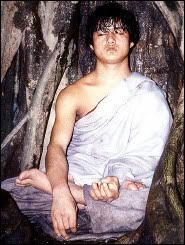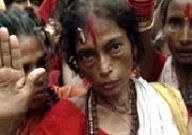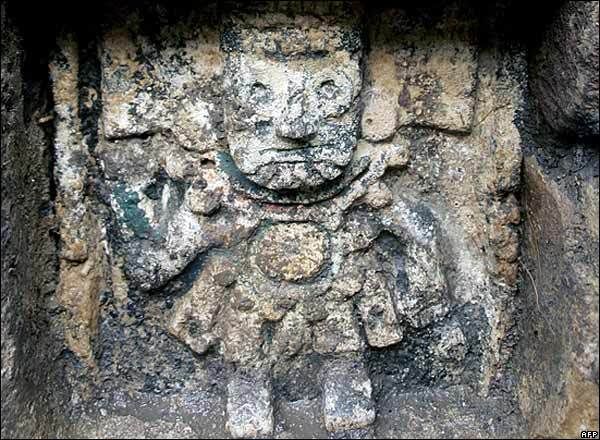¨˜”°º• LOA Times 2006 : Global NewsRoom •º°”˜¨
-
Originally posted by marzguy:
long time no see
[b] wah new birds new flowers
wah new birds new flowers  Wonder what part of the world yet to be found by humans [/b]
Wonder what part of the world yet to be found by humans [/b]
i believe there is still alot of stuff that has yet to be found by human which makes this world interesting
-
wrong thread

-
From spooks to Satanism – one person's trick is another's treat
By Rob Gibson
While you are shopping for pumpkins and painting your children's faces
white, spare a thought for reporter ROB GIBSON who went in search of
those who believe there is more to Halloween than sweets and cheap
masks.
The origins of Halloween date back 2,000 years to an ancient Celtic
festival, Samhain - a celebration of the new year on November 1.
From spooks to Satanism – one person's trick is another's treatThis
day marked the end of summer and the harvest and the beginning of the
dark, cold winter, a time of year that was often associated with human
death.
On the night of October 31, the Celts celebrated Samhain, when it was
believed that the ghosts of the dead returned to earth.
They wore costumes consisting of animal heads and skins and attempted
to tell each other's fortunes.
For most people Halloween 2006 means a handful of trick-or-treaters
and several more than a handful of hoodlums armed with eggs and flour.
But some local folk will be thinking of bigger things - things that
really do go bump in the night.
City man Tony Stacey practices devil-worshipping.
He will be celebrating Halloween in London with a 'black metal smash'
involving several heavy metal bands.
Tony said: "It's a festival that attracts people from across the
country but people think it should be banned.
"We were planning a big ritual down in New Bradwell but it's been cancelled.
"People have got to realise how far this goes back - to the Druid's old rituals.
"It's a big thing for us, not a game, and to us it's more about history."
Tony's tastes are a little more Exorcist than Ghostbusters but one
paranormal group prefers good spirits.
Karen Parker founded the MK Spookologists four years ago with a group
of friends. They now meet twice a month to investigate and search for
paranormal activity in Milton Keynes.
Karen said: "Some of the people are 'sensitive' so they can hear or
feel spirits in the room - that's how they help us.
"Other people can act as a medium to contact the spirits."
At the end of the investigations the group collates the information
and look for any conclusions.
But Karen is aware that a good sense of humour is crucial.
"We are really weird and spooky people," she joked.
Halloween"They are a great bunch of people and we have about 10-15 core members.
"When we go out to some places there's nothing there.
"Even if you go in you have to have the understanding that it could be fake.
"We find out what it is rather than saying it's paranormal straight away.
"A door could slam if someone left the window open.
"It could be a fox and not a Banshee."
On Friday night they will spend four hours searching Bletchley Park.
Previous investigations have lasted up to nine hours and involve the
use of sophisticated thermal cameras.
Karen said: "We do it at night, not because that's when the spirits
are out but because it is a lot quieter and there is less disturbance.
"One night we stayed in Bletchley Park until 7am when a mist came out
and then suddenly disappeared.
"And we saw lots of activity up at the Black Horse pub in Great
Linford. If your house is old then we could come over and we would
probably find something." But Karen offers some assurance for people
who believe their house may be haunted.
She said: "I got into it because I had a little girl who lived in my
house and 'passed over'.
"I was living by myself and it scared the hell out of me, but then I
started talking to her and it all stopped. When you get into spiritual
work you get into a different side of it, like messages from the grave
that allow people to know they are ok."
But there are dangers for anyone who tries to tamper with the 'other
side'. I don't do Ouija boards because unless you're in total control
you are opening the door up to anyone," Karen warned. You could get
someone who's not a very nice person and because you can't close the
door they could stay with you.
"You should only do it in a controlled environment." -
long time since the last update

-
Good things need time mah.Originally posted by scorpboi:long time since the last update
-
yeah~~~Originally posted by Karkadann:Good things need time mah. -
Wow. I love this thread. Especially the malaysian stuffs... scarrry.

-
me tooOriginally posted by mhcampboy:Wow. I love this thread. Especially the malaysian stuffs... scarrry.
its one of the many interesting thread in LOA
-
Ghosts and necropants
Museum of Sorcery & Witchcraft in west Iceland, where visitors can observe obscure magical objects and learn how to scotch ghosts, is steadily growing in popularity.
The Witchcraft Museum in HólmavÃk, Strandir, opened in 2000. “The Strandir area has always been notorious for witchcraft and that sparked the idea of the museum,” Sigurdur Atlason told icelandreview.com. He is the manager of Strandagaldur, the company behind the museumÂ’s exhibitions.
The Witchcraft Museum has gained popularity in recent years, last year it had 8,000 visitors. So far mostly Icelanders have visited the museum, but tourists are becoming increasingly interested.
“All the information is in Icelandic, English, German, French, and by next summer in Italian too,” Atlason says. He adds: “It is important to us that tourists from all nations can enjoy the exhibitions.”
In HólmavÃk visitors can learn about the witch hunt in Iceland in the 17th century, take a look at magical objects on display and take part in scotching ghosts on special ghost days. The most popular object in the museum are the so-called necropants.
“Necropants are part of a complicated sorcery for gaining money,” Atlason explains. “The owner of necropants had to make a deal with a male friend while still alive about digging up his body after a natural cause of death, skinning it below the waste and wearing the skin as necropants.”
Atlason continues: “Then the necropants-owner would have to steal money from a poor widow and draw a magical symbol on a piece of parchment. After placing both in the necropants’ ‘pouch,’ the owner would magically come into possession of money.”
The original idea of the Witchcraft Museum was to spread the exhibitions out over the Strandir area. Apart from HólmavÃk there is a magical exhibition in Bjarnafjördur fjord called the SorcererÂ’s Cottage.
Two other exhibitions are planned: One in TrékyllisvÃk inlet, where sorcerers used to be burned alive, and another one in HólmavÃk to be finished in 2011, comparing the witch hunt in Iceland and in the rest of Europe in the 17th century.
“In Iceland mostly men were accused of witchcraft, while in Europe mostly women were burned alive after being condemned as witches,” Altason says. -
interesting magickal artifacts are always on display in many countries
hope it come to singapore soon
-
LOA does have alot of original threads that are interesting and rarely heard of.Originally posted by scorpboi:me too
its one of the many interesting thread in LOA
-
yupOriginally posted by Karkadann:LOA does have alot of original threads that are interesting and rarely heard of.
so rare such that at most 1 in 20 person knows something about it -
The knowledge we accquire here is beneficial to us all and allows us to grow as a person.Originally posted by scorpboi:yup
so rare such that at most 1 in 20 person knows something about it -
yaOriginally posted by Karkadann:The knowledge we accquire here is beneficial to us all and allows us to grow as a person.
just need to take some time to read n understand
-
Daily newsroom this is?

-
not dailyOriginally posted by waliao:Daily newsroom this is?
i think this thread will be updated when OCEANOS found any interesting article
so be sure to check back for more interesting news more often
-
bump

-
Nepal's "Buddha Boy" reappears
A Nepalese teenaged boy who was hailed as a reincarnation of the Buddha has reappeared after nine months of wandering through the jungles of eastern Nepal, police said.
"A team of police found the Buddha Boy sitting under a tree in the Piluwa jungle after there were rumours that some locals had spotted the boy on Monday afternoon," said Rameshwor Yadav, a police officer in the Bara district, 170 kilometers (106 miles) east of Kathmandu.
Ram Bahadur Bomjan, 16, had disappeared in March after he reportedly shunned food and water for almost 10 months while he meditated under a pipal tree in Bara near a holy site in Nepal revered by Hindus and Buddhists.
The event had drawn hundreds of devotees daily who offered money and gifts for the "Buddha Boy," but were barred by Bomjan's supporters from reaching within 50 metres of his meditation spot.
Local officials however had expressed scepticism on the impossible fasting claims and said the boy was being used by supporters to fleece funds from villagers.
The Gautam, or Enlightned, Buddha was born a prince in Lumbini located in Nepal's low-land jungle around 500 B.C.
He shunned his life of privilege and wandered for many years before he obtained enlightenment at Bodh Gaya in the eastern Indian state of Bihar on Nepal's southern border.
Bomjan reportedly told local villagers that he disappeared from the previous meditation site because of noisy crowds, Yadav said. -
Indian state gripped by fear of witches

NEW DELHI: Authorities in a remote area of eastern India have appealed to the public not to conduct witch hunts following rumours that roving bands of witches had been killing people swept the region, media reports said Wednesday.
Panic has spread through Chhattisgarh state following reports that witches were knocking on people’s doors and asking for onions and chapatti – local staple foods – and that anyone who handed out the food would die.
Chhattisgarh, IndiaÂ’s most impoverished state, remains deeply traditional and superstitions and beliefs in the occult are rampant. Last year at least 10 women were killed there on suspicion of being witches.
“We have asked people not to believe in gossip mongering and try and think rationally,” Subodh Kumar Singh, a local government official told the Indian Express newspaper.
“Awareness campaigns have also been launched asking people not to harass women by calling them ‘tonhi’ (witch),” Singh was quoted as saying.
Many people, including local politicians, daubed prayers written in cow dung on their walls in the belief that it would ward off witches, the newspaper reported. The paper did not report any actual deaths attributed to the current rumours.
Local officials could not immediately be reached for comment. -
Mystery Over Unusual Rock Find

Kevin Oliver said he's sure he doesn't have rocks in his head. He does, however, have a big one in his living room. It's brown, weighs some 40 pounds and is hollow in a few places. Oliver said he thinks it's worth big bucks. ''This is no ordinary rock,'' he said. At a glance, local geology buffs haven't been able to identify the rock Oliver came across while clearing underbrush on property in north Abilene. ''It's about to drive me crazy,'' Oliver said. ''I want to find out what it is.'' Months ago, ''I picked this thing on up and I thought, 'What the ... ''' Oliver said. Because the rock looked so odd, Oliver said, he took it home and hosed it off. It's smooth but not perfectly round and about a foot and a half in diameter. Oliver said he took it to the geology departments at Hardin-Simmons University and McMurry University. Professor Richard Schofield said that in his 22 years with McMurry's geology department, he's never seen anything like it. In looking at the rock, he couldn't determine its composition, age or origin. Its partial hollowness could be from weathering, Schofield said. As for its value, Schofield said, ''It could be nothing, but I can't say with any certainty.'' He suggested Oliver send the rock to Texas A&M University, where staff could cut a sample to study.
Charles Lightfoot, a longtime member of the Central Texas Gem and Mineral Society, said the most common rocks in the Abilene area are fossils and agate, a striped gemstone. ''It's hard to say what he found,'' Lightfoot said without having seen Oliver's rock. A diamond in the rough, Oliver likes to think. -
hmm..what so special with 1 stone with 1 hole. So many lying arond. Couldn't blame those who are ignorant about rocks.
-simply undaunted- -
Aztec ruins unearthed in Mexico
Archaeologists working in Mexico City have discovered an Aztec monolith, the most important ruins of the ancient civilisation to be found in decades.
The monolith and an altar, dating from the 15th Century, were unearthed in the very heart of the busy capital city.
Archaeologists say the ancient stone figures carved into the altar represent Aztec gods
The city's mayor described the discovery as the biggest in almost three decades.
A figure representing the rain god Tlaloc and another unidentified figure are carved into a frieze on the altar.
Under the surface
The discoveries were made near the ruins of the civilisation's main temple, the Templo Mayor, near the city's central Zocalo Square.
"It is a very important discovery, the biggest we have made in 28 years. It will allow us to find out much more," Mexico City Major Alejandro Encinas said.
The stone slab is some 3.5m (11ft) in height and much of it remains buried beneath the surface.
Archaeologists say they think it might be part of an entrance to an underground chamber.
The ancient Aztecs began the construction of the Templo Mayor temple in 1375.
It was discovered, by accident, in 1978 when electricity workers came across a vast carving of an Aztec goddess. -
but how often can u find a hollow rock?Originally posted by Undaunted:hmm..what so special with 1 stone with 1 hole. So many lying arond. Couldn't blame those who are ignorant about rocks.
-simply undaunted-
-
Originally posted by OCEANOS:
[b]Bush's 'spirit' cursed with black magic, tossed into river
October 19, 2003
The spirit of US President George W Bush has been trapped in a clay pot and tossed into a river in northern Thailand after being cursed by hundreds of farmers protesting US agriculture policy.
A photograph of the US leader was sealed inside a pot amid black magic mantra chants, then tossed into the Ping River on Friday by demonstrators after they rallied at the US consulate in Chiang Mai, a farm group leader said.
"This is a traditional northern Thai ceremony aimed at keeping his spirit down on the riverbed so he could not come and exploit our natural resources or suppress our (farming) brothers with his superior influence," Weerasak Wan-ubol, an executive of the Northern Farmers Alliance, said today.
The 300 protesters, claiming to represent 20,000 members from seven northern provinces, railed against imminent plans for a free-trade agreement between Thailand and the United States.
The act was also a protest against Washington's military intervention in sovereign nations, the Bangkok Post reported.
A respected elder performed the voodoo rites, inscribing ancient Khmer scripts on the pot, aimed at trapping the spirit of the US president.[/b] -
Plenty of happenings lately...
